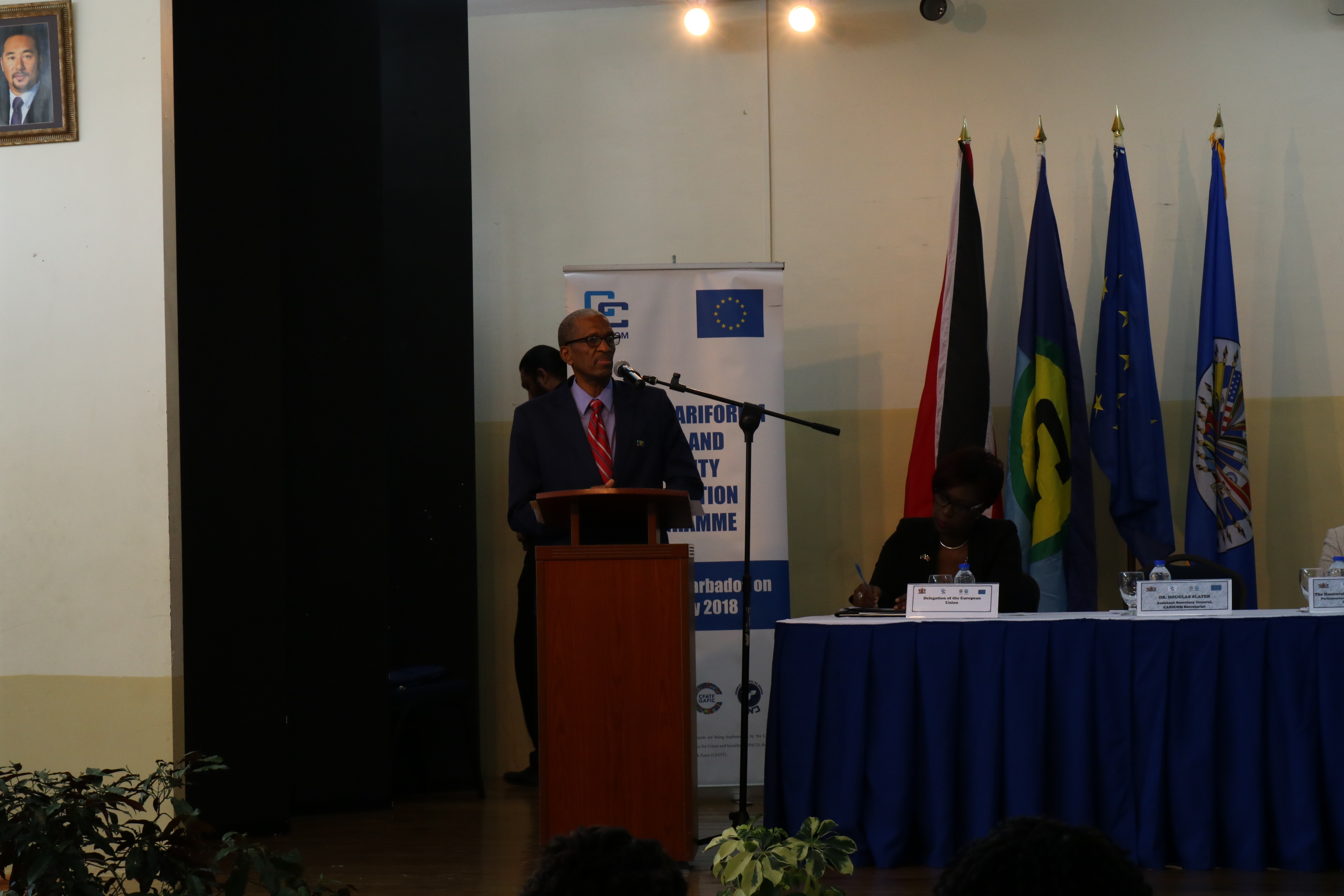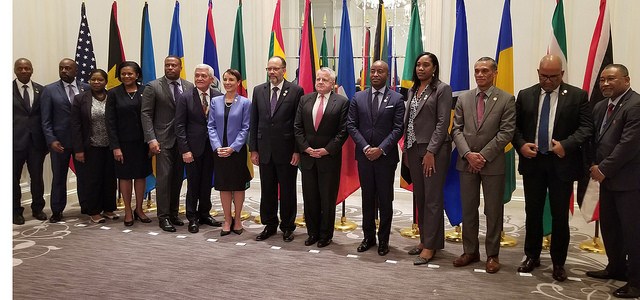Theme: THE ROAD TO COPENHAGEN : Choosing options, speaking with one voice
Background
It is my pleasure to address this workshop which challenges the world and in particular members of coastal states to join voices in securing a just and secure climate change agreement at Copenhagen in December 2009. We are therefore all here for a noble cause at a time of economic and financial crises. We could have no doubt of the enormity of the task if we heed the conclusions of the International Institute of Strategic Studies (IISS) Strategic Survey 2007, that climate change “could have global security implications on par with nuclear war unless urgent action is taken”1
For the Caribbean and other Coastal states the issues are real. Sea level rise leads to land and habitat loss, coastal erosion resulting from increased wave intensity and abnormal tide ranges .These effects can cause displacement of communities, salt-water intrusion within freshwater aquifers, impeded drainage, and damage to coastal infrastructure, degradation of coral reefs, mangroves, sea grasses, and loss of wetlands. Countries such as the Bahamas and Barbados, which are almost entirely dependent on groundwater supplies, are among the SIDS most severely affected by sea level rise.
In the Maldives, as a result of sea level rise, a large proportion of the landmass could disappear over the next thirty years. Some islands could be completely submerged by the end of the 21st century. Our interest must be preserving the planet for the world’s people and taking collective responsibility to this end. (UNEP 2007)
This clarion call for awakening to the gravity of the global challenge is reflected in the “Bali Road Map” resulting from recommendations from the United Nations Climate Change Conference in December 2007 which commenced a process of negotiations leading to the Kyoto Protocol 2012 to be finalized in Copenhagen in December 2009 ( just 8 months away) The “Bali Road Map” and the accompanying Bali Action Plan (BAP) identified four major building blocks for negotiations, viz: mitigation, adaptation, technology development and transfer, and finance.
The Poznan, Poland, Conference in December 2008 was considered the half-way point in the negotiations at which the Parties were expected to establish a “Shared Vision” Instead there was a ‘vision gap’ mainly between the developed and developed countries in particular the US and the EU. Hence the road to Copenhagen could be quite rocky with several hurdles along the way.
Among the main issues of great importance to the Caribbean and other coastal states are: financing mitigation and adaptation in developing countries; financing the convention and the Kyoto Protocol; additional and predictable resources; mitigation linked to technology transfer; and an agreeable financial framework. In all this we must put a human face to the resolution of this process.
Financing mitigation and adaptation in the developing countries
The organization of the financial flows for mitigation and adaptation is the keystone of the Climate Change Convention and the Kyoto Protocol. There is wide agreement that finance is crucial for the implementation of all commitments that make up the new agreement for Copenhagen. Today the majority of resources are provided by the Global Environment Facility (GEF), the financial mechanisms of the Convention. However, many developing countries within the Group of 77 and China have been advocating for a change in the current system that better addresses their needs.
Financing the Convention and Kyoto Protocol
The GEF was created in 1991 in preparation for the Rio Earth Summit. It is the financial mechanism of the three conventions originating from that summit (climate, desertification, biological diversity). It is required to report to the Conference of Parties on the use of finance devoted to combating global warming. Other Funds came on stream and were designated to finance a variety of projects. These funds which total approximately 9.4 Billion are derived mainly through voluntary sources administered through UN protocols and managed by the World Bank. However, what will continue to be part of the discussions leading up to Copenhagen is how to overcome the current trend toward dispersion, fragmentation of the finances and public policies on the one hand and the serious lack of resources on the other.
New, Additional, Sustainable and Predictable Resources
The bottom line on the negotiations is promoting coherence in financing climate change coupled with harmonization of policies with respect to accountability. In light of these circumstances the Group of 77 and China has been advocating for new and additional funds, beyond Overseas Development Aid (ODA). However, the donor countries have consistently raised concerns about the multiplication of funds being held at various institutions and the risks of diversion of ODA to climate change. The donor countries have also raised concerns over the duplication of initiatives that may also be detrimental to the effectiveness of the aid such as that promised in the Paris Declaration. Promoting financial coherence in the context of negotiations implies an adequate institutional structure for managing and distributing resources. This does not exist. However, the Group of 77 and China has adopted the position that any funding pledged outside of the United Nations Framework Conference on Climate Change (UNFCCC) should not be regarded as the fulfillment of commitments under Article 4.3 of the Convention. The EU and USA are so far opposed to this.
Mitigation and Technology Transfer: The nexus between Climate Change and renewable energy
The Caribbean and other coastal states need to advocate for programmes that stress mitigation and technological transfer with special emphasis on low carbon development strategies. In addition to this, combating deforestation, which is responsible for 20% of Green House Gases (GHG) emissions, must also be taken into consideration. In the Caribbean this aspect of the negotiation is particularly pertinent to Belize, Dominican Republic, Guyana, Haiti and Suriname In this regard equity in the agreement will mean that an important part of the finance must originate from developed countries, and must take into account the “polluter/payer’ principle and the principle of common but differentiated responsibilities i.e. differentiated according to respective capabilities.
Adaptation to the impacts of climate change
Another important issue for the agreement is the strategy for adaptation to climate which when translated into the sum required by countries facing climate change vary according to mitigation and level GHG stabilization scenario. The World Bank in a report issued in 2006 estimates that the developing countries will require approximately 10 to 40 billion US dollars per year to cope with climate change. The Stern report published just prior to the Nairobi Conference at the end of 2006, evaluated the expenses required for adaptation as approximately 0.2% of global GDP.
The NGO, Oxfam estimates that a sum of 50 billion dollars will be required per year to cover the cost of adaptation to climate change. The UNFCCC report published in 2007 places the requirements for adaptation by the developed countries as being between 28 and 67 billion dollars per year by 2030. For its part, the United Nations Development Programme (UNDP) has estimated the requirement at 86 billion US dollars by 2015. These costs are central to the negotiations and more importantly to the kind of world we wish to provide to future generations
Vulnerability assessments
Developing countries must speak with one voice in determining an adequate response from the developed world and not be diverted by administrative conditionalities. One binding issue is the vulnerability we share.
As a result of the climate change impacts already experienced in the Arctic and SIDS, there is a demand for accurate assessment of regional vulnerabilities to climate change and confident projection of future regional changes. In this way, appropriate adaptation strategies involving long-term planning of infrastructure, biodiversity conservation, and economic resources can be earmarked and mobilised to respond to climate change impacts. In both regions, vulnerability assessments have been performed to assess the risk to sectors potentially affected by climate change
It is clear that a significant part of the finances will come from private investment, framed and reoriented by incentive policies, financial instruments and/or standards and regulations. It is also clear that emphasis will have to be placed on finding additional significant finance which means exploring several new paths:
• extension of carbon trading and project mechanisms
• revenue drawn from auctions of carbon emitting rights, either within national or regional markets or at the international level
• taxes on green house gases (GHG)
Some proposals for global financing
Mexico proposes to create a World Climate Change Fund (Green Fund) to enable extension of the participation of various countries in favour of clean development and technical and financial support of reduction and adaptation initiatives. This mechanism could be part of the global agreement to be negotiated at Copenhagen in 2009.
Switzerland has proposed the creation of a solidarity mechanism to finance adaptation, based on a system of taxing CO2 emissions linked to the burning of fossil fuels. The tax level proposed is US$2 per tonne of emitted CO2. that is approximately 0.5 cents per litre of petrol. An exemption would be envisaged below a threshold of 1.5 tonnes of CO2 per inhabitant, in order to take into account the principle of common but differentiated responsibilities and the capability of acting. Approximately 18 billion dollars could result from this tax (of which more than 75% form the developed countries) Switzerland envisages its proposal as complementary to the other envisaged devices, making explicit reference to the Mexican proposal.
Norway proposes financing adaptation by auctioning emission rights for Annex 1 developed countries (Assigned Amount Unit AAU). Norway also proposes that a small percentage of the value of the allocated emissions rights could go to finance adaptation, either by auctioning these rights or by a tax on their issuance. According to calculations, 2% of the auctioning of the AAUs would generate between 15 and 25 billion dollars per year. Of course, the revenue derived from the auctions would depend on the level of commitment of other countries which have a legally binding reduction target for their emissions. The higher the level of constraint, the more significant the revenues would be. By contrast, targets that are only modest will cause the prices to drop and therefore the finance capabilities also.
These proposals highlight the differentiation between financing for adaptation and financing for mitigation given that financing for mitigation is more readily available and easier to access than financing for adaptation. So what is the emerging position of the Caribbean Community?
Speaking with one voice: AOSIS Position at the Poznan Conference (inclusive of the CARICOM Member States Position)
Since I come from the Caribbean region please permit me to elaborate on some of the steps the region has embarked upon. As you may be aware Alliance of Small Island Developing States, which is made up of 43 small-island and low-lying coastal developing countries, is the main platform in the UNFCCC process representing the concerns of SIDS. The CARICOM Countries are fully aligned with the positions being promoted by the Alliance of Small Island development States chaired by Grenada.
Hence AOSIS outlined the following principles on which future arrangements for adaptation financing should be based:
New and additional – A significant injection of new money over and above traditional ODA and the 0.7% target, and specifically devoted to adaptation is need.
Predictability – The sources of this new financing must be stable and predictable including from mandatory or assessed contributions from developed countries and levies on the carbon markets and other emissions trading schemes
Grant-based – Consistent with the polluter-pays-principle financing to developing countries for adaptation should be in the form of grants rather than loans. SIDS are being forced to adapt to the adverse impacts of a phenomena caused by the carbon intensive lifestyles and production patterns of others.
Priority access for the most vulnerable – Particularly vulnerable developing countries especially the SIDS and LDCs should be given priority access to any financing for adaptation given their unique vulnerability, limited capacity to adapt and negligible contribution to the problem.
A New Approach to Governance – Any new financing should be channeled through the Convention and any new Fund(s) for addressing climate change should be under the guidance and supreme authority of Parties to the Convention. The governance arrangements of the international financial institutions place small countries at a distinct disadvantage and more often the priorities of these institutions mirror the priorities of those in control.
Coherence – Coherence and coordination at the international level among all actors and utilizing the Convention as the fulcrum for action.
In addition AOSIS made three specific proposals – a Convention Adaptation Fund, an Insurance Mechanism and a Technology Fund.
The Caribbean Community has taken steps to enhance its role in these negotiations. It established a Caribbean Community Climate Change Centre in Belize as a coordinated policy implementation mechanism based on a regional climate change strategy that is intended to foster collaborating with governments, private sector, universities and NGOs. It has also established a Task Force on Climate Change and Development to give direction to the priorities and police formulation as we move toward Copenhagen and beyond.
Our political leaders are seized with the need for engaging more in the negotiating theatres recognizing that most of the technical work has been done. There is need for political will and a will not to delay the global agenda for climate change in the face of the global financial crisis. To do this would be a grievous error.
Ladies and gentlemen this is a time when we must take bold steps by acting collectively with One Voice to deal with the complex and interrelated aspects of Climate Change: failing which, we would contribute toward the persistent poverty, accelerated migration, and further erosion of the quality of life and the economic viability of the World. We have much work to do as we prepare for Copenhagen in December 2009. Let’s demonstrate the true meaning of our togetherness as we walk this road together: many voices, many languages but speaking with one voice
I expect that this Workshop will point the way to this objective and I wish you all success in your deliberations.
________________________________________________
1 International Institute of Strategic Studies (IISS). Strategic Survey 2007





